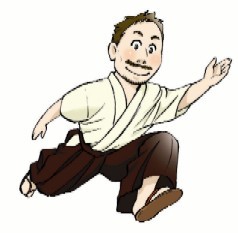Work in Japan Advice Board


- Jobs in Japan @ Daijob.com
- NANBA: Art of Physical Finesse
Creative Career Path
NANBA: Art of Physical Finesse2009.08.26
 Nanba is a word you may not have heard. If you’ve ever been in trouble, it is probably closer to you than you think.
Nanba is a word you may not have heard. If you’ve ever been in trouble, it is probably closer to you than you think.
The word Nanba (ナンバ、難場) literally means tight spot or trouble spot. In Japanese a more common word is yabai, which could be translated as either dangerous and risky, or amazing and cool. The word yaba (矢場) was actually in use in the Edo Period (1603-1868), with the characters meaning arrow-place, warning of danger. Interestingly, danger is often paired with opportunity, the literal meaning of the characters in the word for crisis (危機).
Nanba now refers to the art of improvising your way out of trouble and into opportunity. Because it has a strong kinesthetic component, I call it the art of physical finesse. This is to contrast it from the conventional idea of physical fitness. The word finesse comes from the French, meaning skill or subtlety in handling a difficult situation, hence physical finesse seems a fitting translation for the word Nanba.
It is also surprisingly close to the definition which Wynton Marsalis, Artistic Director of Jazz at Lincoln Center, gives to improvisation, the ability to make things up that could get you out of a tight spot.
While some people seem to have a knack for this, natural talent can only take you so far. Like the tortoise and the hare in Aesop’s Fables, when things come too easily to you in the beginning, you may find yourself unprepared to deal with real struggles which come later. This is why early hardships sometimes forge strong survivors.
Fortunately, there are ways in which you can develop this ability, and many applications for Nanba in daily and professional life. While it is fast fading from modern Japanese life, it thrives in many of the martial and traditional arts of Japan. Under different names it thrives in Jazz and Classical Music, as well as in sports like basketball and baseball. In fact, Japanese Olympic champion runners Takahashi Naoko and Suetsugu Shingo have both integrated Nanba into their training.
Nanba was once an integral part of the body movements of Japanese people in the Edo Period, with variations suiting each class from Samurai, to Farmers, to Artisans, to Merchants. The hikyaku (飛脚), or fleet-footed messengers were able to run from Edo to Kyoto, approximately 500 km, in as little as 3 to 6 days, a journey which took normally took 30 days on foot. Diaries of Westerners who visited Japan at the end of the Edo Period contain remarks on how curiously and efficiently Japanese used their bodies.
Their way of walking was more compact and connected, with a lower center of gravity,
smaller steps without swinging the arms. You can visualize this by watching how Samurai
and people in Kimono move in Japanese historical dramas. Why did it change?
Some
suggest that it was the introduction of Western clothing and furniture, which allowed for
looser and less connected body movements. Elementary school children in the early Meiji
Period (1868-1912) were trained to walk not in Nanba style but in Western style, swinging arms and legs on opposite sides. More accurately, it was not Western but military style which they were imitating. The most extreme form of this is the goose step march cultivated later by the Nazi military machine, more robotic in style, and synchronized for the purpose of control.
Whether or not this had a role in Japan’s own march to militarism is a subject for speculation, but as a result of this rush to imitate the so-called Western walking style, Nanba movements have virtually vanished from modern Japanese life, except where it is practiced as a specialized application. Ironically, had they copied instead the walking style exemplified by the skilled horseman and heroes of the old Westerns, it might have been closer to the legacy of the Samurai. When Charles Bronson and Toshiro Mifune starred together in a classic Western, The Red Sun, it made sense to both sides.
For those interested in learning more about Nanba today, we owe much to Kono Yoshinori in the traditional martial arts, and to Yano Tatsuhiko for spreading applications of Nanba in daily life, music, and sports. Because most of the information about Nanba is available in Japanese, I have taken on the mission of making it accessible in English.
Recognizing the inherent connection between mind and body, NANBA is a way to be and develop yourself to your full potential, combining the arts of improvisation and physical finesse.
It is a way to enhance performance and reduce stress, drawing on principles of natural design and movement, based on 3 core principles:
1. Don't Force
2. Don't Twist
3. Don't Disconnect
Though Nanba has highly developed forms in Japanese culture, it exists under different names in all cultures, and can be applied by anyone to enhance enjoyment of daily life and improve professional performance. As an instructor I conduct and participate in regular training and events to teach Nanba, and I am developing ways to teach this both in person and on line. I have launched two sites to house English language information about Nanba, the Art of Physical Finesse.
Webbrain at: http://budurl.com/5j5z
Website at: http://www.nanba-finesse.com
Look for upcoming information on events and training opportunities.
William Reed
Article Writer
William Reed is a renowned author-speaker who coaches physical finesse and flexible focus for a creative career path. A certified Master Trainer in Guerrilla Marketing and 7th-dan in Aikido, he combines practical wisdom of East and West to help you learn personal branding at the Entrepreneurs Creative Edge.
Similar Articles
- 2015.08.04A Comparison between Western and Asian D...
- 2015.07.28Being an Effective Communicator
- 2015.07.21Making Your Presentation Interactive




